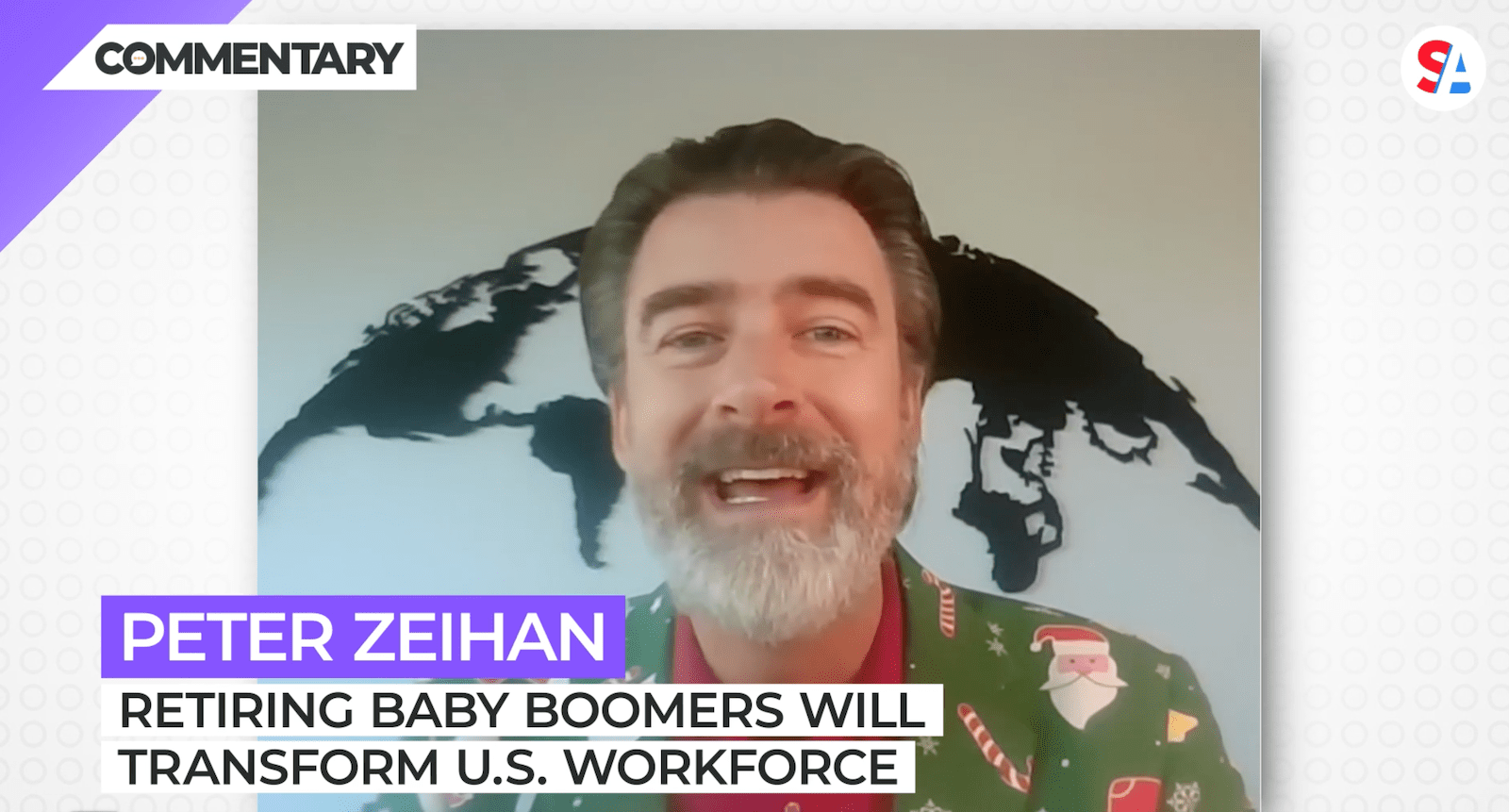
Commentary
-
Our commentary partners will help you reach your own conclusions on complex topics.
Merry Christmas, Happy Kwanza, Happy Hanukkah, happy holidays, whatever makes you happy.
I’m Peter Zeihan. Hello from Colorado. I’m actually transmitting from home today. And because there’s not a lot going on in the speaking circuit over the holidays, I figured I would record a few videos to kick out so you guys had some idea of what’s going on in the world under the hood. We’re not gonna talk too much about the big, big issues that are dominated the news, because most of the cuts that we’re seeing are from the wrong point of view. We will later in this series, talk about Iran and talk about Russia, Ukraine, and all that good stuff, but there’s a lot going on, just below the surface that is having a much bigger impact on everyone’s lives right now.
And the first thing I want to discuss is this great transition we are seeing in the workforce. We know that unemployment is already nearing record lows, and it’s only going to tighten further. We’re seeing labor inflation and everything that you can imagine from fast food restaurants to software development. And none of it is going to go away anytime soon, because it’s not just about economic forces. It’s not just about COVID, it’s about us and we’re all aging. And that means our democracy, our demography is shifting.
This is a standard demographic profile. This is Angola. So children at the bottom, adults mature adults retirees at the top. This is a classic pre-industrial pyramid where most people are living in either small towns or on the farm scraping by an agricultural existence. There aren’t a lot of countries left like Angola in the world. Industrialization and urbanization, those two forces have been reach shaping the human condition ever since the Americans introduced the globalized world back in 1945. And as populations, age, and as they urbanize and as they industrialize, they have fewer kids, which means that wide section at the bottom starts to narrow.
And if birth rates stay low, if people keep having fewer kids, eventually you get more mature adults than young adults and children. And that’s a situation in Italy today. This is a country that is now aged past the point of any hope of natural population resurgence because now that bulge in the population is above the age of people that can have kids in large numbers.
Now here in the United States, we’re not nearly that far. Ours is a bit of a chimney, but there still are a lot of very specific variations in it. And the generation that matters most to the Americans in all things and has mattered in all things since the fifties are the baby boomers. Now they have been our largest generation ever. At their peak, there were over 75 million of them.
But what they’re going through right now is this little thing we call retirement. And it has lots of outcomes for finance and for consumption for production. But for purposes of this specific video, it’s a workforce issue because when you’re retired, by definition, you are no longer working. Now we have always known that in calendar year 2022, the majority of the American boomers will have retired cause they would’ve turned 65. That’s just how the math works.
Because of COVID, it might be happening a little sooner.
We know that well over a million and a half baby boomers have taken early retirement. So it’s entirely possible that we are already past their peak employment moment. Now this has all kinds of implications, but let’s break it into roughly two categories.
So first of all, the impact: 75 million boomers, 37 million of them are already retired. This is just a gross impact upon the labor market. We’re taking our single largest chunk of the labor force. Our most skilled, our most experienced part of the labor force and removing it. And they’re never coming back. You don’t spend forty years in a factory, retire and then come back to the factory full time. This group, their skills, they are gone. And it will take us years to decades to rebuild that in a new generation. That’s how it always works.
What’s different about this generation is that it’s just so much larger than Gen Xers, which are the next generation down. Even today, there is still three boomers for every two gen Xers. cAnd that is something that is going to push up. Their absence is something that is going to push up labor costs for decades to come. And it’s gonna hit some sectors more than others.
Think about people in their fifties and sixties. What are the jobs that they dominate? They’re all in upper management. So if we take all of the people who are running our economy right now and remove them, the next generation, gen X, simply does not have enough feet to fill those shoes. So we know we are looking at deep structural issues at the top of every company. And it’s not just in management. We became convinced at some point in the sixties, seventies and eighties, that white-collar work is where your shoots on your kids.
That is where you can guarantee the American dream. That’s where they will be upwardly mobile and earn more than you did when you were working your fingers to the bone. And this push from blue-collar to white-collar meant that starting with gen X and linked to the current generation, we have seen a steady dropoff in interest in the sorts of jobs that provide the nuts and bolts for the economic system.
Blue collar of all types, but specifically in trade, such as carpentry and welding and drywall work and construction. We just have seen a collapse in the availability of staff. Well, the Baby Boomers were the last generation that had a deep cadre within them to fill these roles. And now they’re all leaving. So not only are we looking at a general reduction in the size and skill of the labor force, we’re taking some huge melon scoops out of some sections that were already under a lot of price pressure.
And probably the one that had the most price pressure is one that’s critical to everyone, not construction, not carpentry… trucking. The United States transports roughly half of all of its cargo by weight, by truck. It’s something like 70% by value, and truckers do not simply drive from point to point. This is not an easily automated replace job because they’re also inventory managers and mechanics. It’s a combination of complex mix of blue-collar skills that is now leaving the workforce.
Now I’m sure a lot of you have noticed that it’s not just American baby boomers who do this. We also get a lot of Mexican truck drivers in the United States, but check this out roughly 25 years ago in 1995, the Mexicans had the tequila crisis. And one of the many, many government responses to that financial crisis was to double down on operationalizing the new NAFTA Accords.
And so Mexico began the large scale process of urbanization and industrialization. And the birth rate dropped. It’s been dropping for 25 years, which means that we’re not exactly running outta Mexicans. It’s not that bad, but we’re never gonna get any more. Net migration from Mexico to the United States has been negative for 10 of the last 11 years. And it’ll probably never be positive again. So the population that the United States has relied upon to supplement the baby boomers and all those blue-collar jobs, including most importantly, including trucking, it simply doesn’t exist anymore.
We have to do without and nor can we go a little bit further south. Because central America got the Central American Free Trade Agreement just a few years after the Mexicans started operating NAFTA.
So I know we’re seeing all these headlines of swarms of convoys coming north and trying to cross the border. And yes, that is real. And yes, that is something we need to deal with, but it’s not gonna last much longer because those same two twin forces, industrialization and urbanization, have now gutted the birth rate in Central America as well.
Again, we’re not quite running out of these people, but the volume that we have become used to, the volume that has shaped our economy to its current form, simply isn’t there anymore. And in the sectors that they’ve contributed the most – blue collar and trucking and agriculture – the numbers just aren’t there any anymore.
And we simply need to get by in a different way because these populations will never increase again. Or maybe I’m wrong and we’re going to have a massive baby boom tomorrow. But they’re not going to be driving a truck for 20 years. This is our new normal.
So why am I bringing up trucking specifically, aside from just the sheer volume of stuff we move about on the roads? Well, the world is de-globalizing. China’s no longer a reliable partner and in any world where the Americans are not providing global security, the ability of moving parts around on a global basis to participate in complex supply chains becomes questionable.
So we know that a lot of that manufacturing capacity is gonna come back to the United States and that’s great. But more local manufacturing means more in- turn immediate products need to be shuffled around. And we’re talking about building out the American industrial plant by a factor of a hundred percent in the next five to 10 years, at a minimum. That means we need to expand our internal cargo transport capacity by half. That’s going to take a lot of truckers. Now there is one technology out there that looks very promising.
It’s called convoy. And basically you get one dude in a truck and then 3, 4, 5 other trucks follow that truck, nose to tail. And so the one guy can manage the inventory and the mechanical capacity, the repair capacity that is necessary to maintain multiple trucks. The convoy won’t move quite as quickly, but you can do it with fewer staff. Now with each one of these groups, each one of these convoys, is gonna require a software engineer on site for a minimum of the first 10 years of this technology. So not only you’re gonna have your roughneck, your blue collar worker, you gonna have somebody in the closet, basically coding all day long. This can be done with the technology that we have. This can be done with the workforce that we have, but it does require Congress figuring out who’s actually liable for certain things when it comes to automation.
And as we all know, Congress moves very, very rapidly.
-
Global internet in a precarious state, but that could be a positive
Over 500 underwater cables span over 870,000 miles worldwide, serving as the foundation of the modern global internet. Despite their critical role in facilitating communication, these cables often go unnoticed, even as the amount of data transmitted through them has surged. So what happens if the cables fail? Straight Arrow News contributor Peter Zeihan contends…
-
Water wars are an unlikely future
Foreign policy writers have long warned of the possibility that clean drinking water might become “the next oil” — that is, that major wars might be fought around the globe over access to potable water. With expanding populations and finite water supplies, these critics argue that humans will inevitably fight each other to secure drinking…
-
Are Russia’s hypersonic missiles too good to be true?
Russia has reportedly used five of its new hypersonic Zircon missiles to target Kyiv since the beginning of 2024. Russia claims that these sea-based missiles, boasting a range of 625 miles and capable of traveling at nine times the speed of sound, are part of its family of “superweapons” aimed at penetrating the U.S. missile…
-
Norway sending F-16s to Ukraine
In recent months, the need for Ukrainian air defenses has grown more urgent. As U.S. aid is unable to pass through Congress, Ukraine’s European allies have been stepping up to provide what they can. Norway is now the latest nation to pledge F-16s to Ukraine, not only to defend Ukrainian airspace, but also for the…
-
Russians targeting civilian emergency crews in Ukraine
Russian forces are applying a brutal tactic in their war on Ukraine. The tactic, “double tap,” includes an initial strike on a specific civilian target of some value, followed by a second strike intentionally designed to kill the emergency first responders, medical staff, firefighters, and other key personnel dispatched to the location of the first…
Latest Stories
-
 Getty Images
Getty Images
Conservative media isn’t covering Kari Lake Supreme Court dismissal
-
 Getty Images
Getty Images
Supreme Court says it will hear case on Biden’s ‘ghost gun’ ban
-
 Getty Images
Getty Images
Russia's nuclear-capable missiles raise concerns for NATO
-
 Getty Images
Getty Images
Wind power set records in 2023, but offshore projects lagged behind
-
 Getty Images
Getty Images
Chinese doping scandal hits 3 months before Paris Games; US claims cover-up
Popular Opinions
-
In addition to the facts, we believe it’s vital to hear perspectives from all sides of the political spectrum.
Latest Opinions
In addition to the facts, we believe it’s vital to hear perspectives from all sides of the political spectrum. We hope these different voices will help you reach your own conclusions.
The opinions published in this section are solely those of the contributors and do not reflect the views of Straight Arrow News.

















Latest Commentary
We know it is important to hear from a diverse range of observers on the complex topics we face and believe our commentary partners will help you reach your own conclusions.
The commentaries published in this section are solely those of the contributors and do not reflect the views of Straight Arrow News.
Peter Zeihan
Geopolitical StrategistWater wars are an unlikely future
Are Russia’s hypersonic missiles too good to be true?
Norway sending F-16s to Ukraine
Dr. Frank Luntz
Pollster and Political Analyst‘Take the job seriously’: Why Americans are fed up with Congress
‘If we can shrink it, it will stop growing’: Americans talk debt, deficit
‘I don’t think they care’: Undecided voters explain their reasons
Pete Ricketts
U.S. Senator for Nebraska